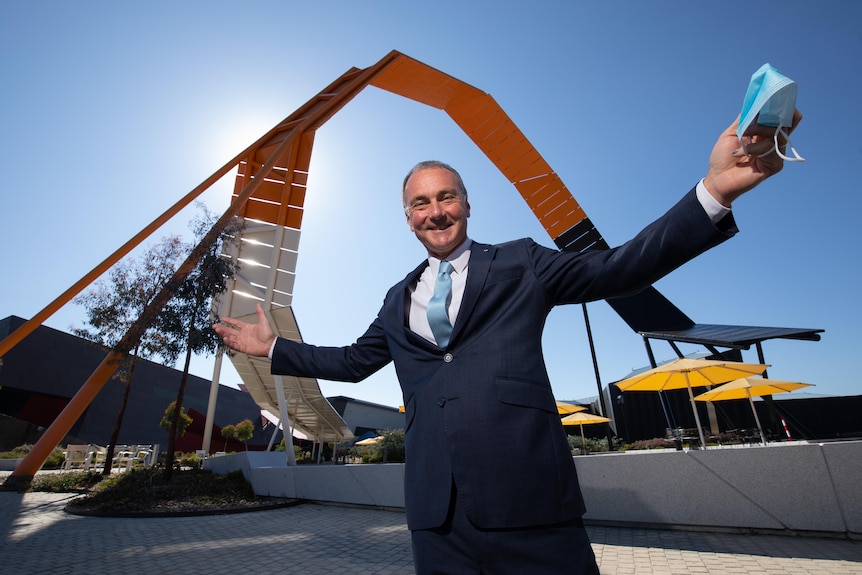Mathew Trinca is the longest-serving director of the National Museum of Australia.(ABC News: Craig Allen).
Craig Allen, Outgoing National Museum of Australia director pushes for institutions to ‘be honest’ about Indigenous history, ABC News, 3 May 2023
Outgoing National Museum of Australia (NMA) director Mathew Trinca has urged historical institutions to “be honest” about the Frontier Wars that marked Australia’s colonisation.
Dr Trinca on Wednesday announced he would step down as director at the end of 2023, opting not to seek reappointment after a decade at the helm of the institution.
In making the announcement, he said the organisation needed “refreshment in leadership”.
As the NMA’s longest-serving director, Dr Trinca oversaw significant redevelopments at the institution, including the creation of new gallery spaces.
He also worked to bring greater focus to Australia’s Indigenous history.
‘A milestone step’ among achievements
Among his achievements was overseeing the return of key Aboriginal artefacts from the British Museum for the first time since they were seized by the crew of Captain James Cook at Botany Bay in 1770.

“That was some of the most challenging work,” Dr Trinca said.
“[It prompted] a discussion about cultural meaning, about rights and responsibilities of the custodial work that museums do.
“And to see now a museum in the United Kingdom decide to return some of those spears that were actually shown [at the NMA] in 2015 …to return them to La Perouse permanently, that’s a milestone step really.
“Not for the museum, but for First Nations people in this country.”
Dr Trinca’s decision to not seek reappointment comes after he helped secure an additional $80 million in budget funding for the NMA, reversing a decade of funding decline.
He said some of that money would go towards remaking the museum’s Gallery of First Australians to more accurately depict the early conflicts between black and white Australians, known as the Frontier Wars.
“The simple and honest truth is that those moments in the early colonial period were devastating for Aboriginal people,” he said.
“There was war here on the Australian continent, waged between First Nations and those that have come after in those early decades. There were massacres on the record into the 20th century.
“We all have to be honest about that deep truth that is there in our past.
“That’s a responsibility for all of us, not just the National Museum.”

Story of the past must be told honestly: Trinca
Dr Trinca acknowledged there had been years of sustained public pressure on national institutions – including the nearby Australian War Memorial (AWM) – to depict an honest account of the Frontier Wars.
The Australian War Memorial has attracted criticism for its minimal depiction of the Frontier Wars.
For his part, AWM chairman Kim Beazley has signalled there will be greater representation of those early Australian conflicts in the institution’s $500 million redevelopment.

Dr Trinca said the story of conflicts that occurred on Australian soil would always have a place at the National Museum.
“It’s not for me to say what the War Memorial should or shouldn’t do — I know what this place should do,” he said.
“This place, in common with a number of other cultural institutions in the country, has to look to their past and tell it honestly. And that’s my view, not just for the National Museum, but for other institutions in the country as well.”
On the issue of the repatriation of Indigenous ancestral remains that are currently in the NMA’s collection, Dr Trinca conceded it was a “work in progress”.
“This organisation has been very invested in the return of ancestral remains to Indigenous communities for more than 20 years,” Dr Trinca said.
“I’m very proud of the work the museum’s done in that regard, but none of this is ever finished.
“I really look forward to seeing what the next chapter is in the museum’s history of work serving the Australian public on these matters and repatriation of cultural property.”
Federal funding a boost after ‘challenging’ decade

Dr Trinca said the past decade had been “enormously challenging” for the National Museum of Australia, which had suffered budget cuts, bushfires, and closures due to COVID-19.
He welcomed the federal government’s recent pre-budget announcement to increase funding for Australia’s cultural institutions, including a record extra $78 million for the NMA.
“I’m delighted by the decision this government has taken to reinvest in these institutions, to reinvest in the museum.”
A total of $13 million has already been set aside for a new off-site storage facility, to replace a substandard unit which had been described as jeopardising the “safe storage of the National Historical Collection”.
“There’s no doubt that the risks for the collection and also for the organisation have grown over the course of that decade,” Dr Trinca said.
“What’s so pleasing now with this announcement that government made is … to see planning and investment in the areas that can really deliver for the Australian public,” Dr Trinca said.
“No one wants to leave an organisation when it’s in financial peril, and this news has meant the museum is able to plan and think about the next four years with a degree of comfort and certainty that has been absent in recent years.
Mathew Trinca was originally appointed as acting NMA director in 2013, after starting at the institution in 2003.
January 2024 will mark the end of his second five-year term.
He said he planned to remain working in Australia’s “broader cultural sector” after stepping down.
The NMA council and federal government are expected to choose Dr Trinca’s successor later this year.

